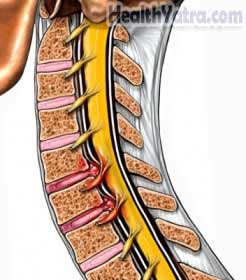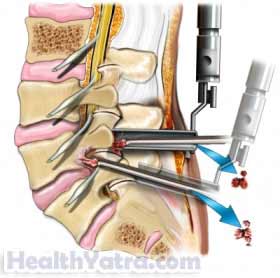Definition
A laminectomy is a surgery to remove a small portion of a vertebra (back bone). The part removed is called the lamina.

Reasons for Procedure
A laminectomy is usually done to help take pressure off your spinal cord or a nerve running out from your spinal cord. It is also done to gain access to the spinal cord, bones, and discs that are below the lamina. Ruptured discs, bony spurs, or other problems can cause narrowing of the canals that the nerves and spinal cord run through. This can irritate the nerve if it gets too narrow. Often, a laminectomy is done along with a disk removal to help make the canal larger and take pressure off the nerve being irritated.
When the spinal cord or other nerves get irritated, they can cause:
- Weakness
- Numbness
- Pain in an arm or leg
Physical therapy and medicine will be tried first. The surgery is done when other treatments have not worked. It is most often done to treat symptoms that keep getting worse.
Possible Complications
Complications are rare, but no procedure is completely free of risk. If you are planning to have a laminectomy, your doctor will review a list of possible complications, which may include:
- Infection
- Bleeding
- Blood clots
- Damage to nerves, resulting in pain, numbness, tingling, or paralysis
- Problems related to anesthesia
Factors that may increase the risk of complications include:
- Another medical condition, particularly heart or lung problems
- Obesity
- Advanced age
- Smoking
Be sure to discuss these risks with your doctor before surgery.
What to Expect
Prior to Procedure
Your doctor may do the following:
- Physical exam
- X-ray—a test that uses radiation to take a picture of structures inside the body, especially bones
- MRI scan—a test that uses magnetic waves to make pictures of the inside of the body
- Myelogram—a specialized type of x-ray that requires dye to be inserted near the spinal cord and shows if there is pressure on the cord or the nerves
- CT scan—a type of x-ray that uses a computer to make pictures of the inside of the body
In the time leading up to your surgery:
- If you are overweight, try to lose weight. This will decrease the amount of stress on your back.
- Talk to you doctor about your medicines. You may need to stop taking aspirin or other anti-inflammatory drugs for one week before surgery. You may also need to stop blood-thinning drugs, like clopidogrel (Plavix) or warfarin (Coumadin).
- Arrange for a ride home and for help at home.
- Eat a light meal the night before. Avoid eating or drinking anything after midnight.
Anesthesia
Possible types of anesthesia for this operation include:
- General anesthesia—blocks pain and keeps you asleep during the surgery; given through an IV in your hand or arm
- Spinal anesthesia—numbs the area from the chest down to the legs; given as an injection in your back
Description of the Procedure
If the surgery is done with minimally invasive techniques, you will only need a few small incisions. The doctor will insert a scope and small instruments into these incisions. The lamina will then be removed using a drill or other tools. Once the lamina is removed, the doctor can inspect the spinal cord and discs that were hidden under the lamina.
In some cases, the doctor will do an open surgery. This involves making a larger cut in the skin over the area in the back that needs attention.
The disc often needs to be removed as well to take pressure off the spinal cord. If it is not a disc problem, the doctor will try to fix the other problems causing the nerve irritation. In rare cases, the doctor may do a spinal fusion. A spinal fusion will involve joining two vertebrae. Lastly, the incision will be closed with stitches or staples.

How Long Will It Take?
1-3 hours
How Much Will It Hurt?
You will have pain during recovery. Your doctor will give you pain medicine.
Average Hospital Stay
This surgery is done in a hospital setting. The usual length of stay is 1-3 days. Your doctor may choose to keep you longer if there are complications.
Post-procedure Care
At the Hospital
While you are recovering at the hospital, you may receive the following care:
- You will have to walk with assistance the evening after surgery or the next day.
- You may need to wear a back or neck brace.
- You may need to wear special socks or boots. These will help to prevent blood clots.
At Home
When you return home, do the following to help ensure a smooth recovery:
- Be sure to follow your doctor’s instructions.
- Keep the incision area clean and dry.
- Ask your doctor about when it is safe to shower, bathe, or soak in water.
- Exercise your legs while in bed. This is to improve circulation and decrease the risk of blood clots.
- Do not lift anything heavy.
- Work with a physical therapist. You will slowly progress from walking to other low-impact activities, like swimming.
- Only take medicine recommended by your doctor. Ask your doctor before taking any over-the-counter medicine.
- Have the stitches or staples removed in two weeks.
Call Your Doctor
After you leave the hospital, contact your doctor if any of the following occurs:
- Signs of infection, including fever and chills
- Redness, swelling, increasing pain, excessive bleeding, or any discharge from the incision site
- Nausea and/or vomiting that you cannot control with the medicines you were given after surgery, or which persist for more than two days after discharge from the hospital
- Pain that you cannot control with the medicines you have been given
- Cough, shortness of breath, chest pain
- Trouble urinating or having a bowel movement
- New numbness or weakness in the hips, groin, or legs
- Joint pain, fatigue, stiffness, rash, or other new symptoms
In case of an emergency, call for medical help right away.
